Published: July 2000
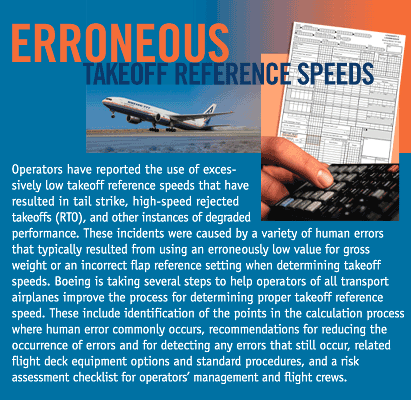
Flight crews consider many factors when determining correct takeoff reference speeds, or V speeds, for a particular airplane on a particular runway. These include gross weight (GW); centre of gravity; flap position; engine thrust level; bleed air configuration; pressure altitude; outside air temperature; wind; runway length, slope, and surface conditions; clearway; stopway; obstacles; and status of any minimum equipment list (MEL) items such as inoperative brakes, spoilers, or thrust reversers. GW itself encompasses numerous components, most of which change for each flight. The result is many opportunities for human error during calculation of V speeds, even when the process is highly automated. Operators have addressed this situation through training and by devising reliable processes for flight crews and dispatchers to follow. However, despite these preparations, occasionally an error occurs that is significant enough to cause tail strike or noticeably degraded performance during takeoff and initial climb. Operators may considerably reduce their exposure to such incidents by slightly adjusting their process for determining takeoff reference speeds, making minor revisions to their associated training, and understanding the information available on the following subjects:
- Typical errors.
- Magnitude of various types of errors.
- Consequences of errors.
- Recommended practices.
- System aids.
- Risk assessment checklist.
1. TYPICAL ERRORS
Determining airplane weight and computing takeoff reference speeds both involve numerous steps, which create many opportunities for human error to occur. Based on the assumption that all elements of an airplane's weight are available and accurate, the following are some examples of human errors that can result in erroneous takeoff reference speeds:
- Making a math error when converting diverse units of weight (for example, pounds to kilograms, or gallons or litres of fuel to pounds), or failing to convert mixed units to the standard unit of weight for that airplane.
- Selecting the wrong weight value from multiple figures on the load sheet.
- Making a keystroke or transposition error when entering weight into the control display unit (CDU).
- Line-selecting weight into the wrong field on the Performance Initialisation (PERF INIT) page of the CDU.
- Selecting the wrong table in the quick reference handbook when determining speeds manually.
- Making an error while using the chart when determining speeds manually.
- Making a keystroke or transposition error when entering reference speeds manually.
- Line-selecting a speed into the wrong field on the Takeoff Reference (TAKEOFF REF) page.
- Selecting an actual takeoff flap setting that is different from the flap setting used to compute takeoff reference speeds.
2. MAGNITUDE OF VARIOUS TYPES OF ERRORS
Simple human errors can cause surprisingly large inaccuracies in takeoff reference speeds (figure 1). Some examples are:
-
Entering zero fuel weight (ZFW) in the GW field can result in a weight error equal to the weight of fuel on board. This error has been linked to several in-service incidents, and the potential for it to occur exists on all flight management computers (FMC) on large commercial airplanes. The FMC has boundaries that define the acceptable range for ZFW, fuel weight, and GW. In many cases, this error will result in a calculated ZFW less than the minimum allowable, and the FMC will identify the invalid entry. However, each model has a range of ZFW and fuel weight that will permit ZFW to be accepted as GW. For a 777-200 Extended Range airplane with 160,000 lb of fuel and ZFW of 430,000 lb, line-selecting ZFW to the GW line would result in a takeoff rotation speed (VR) that is 27 kt too low.
-
In some cases, a transposition error in which a flight crew member reverses two digits of a number when entering it into the CDU may be undetected by the FMC. Many potential transposition errors involving ZFW will result in values outside the allowable range and will be detected. However, certain transpositions that result in a large weight error can be missed. For a 757-300 with a ZFW of 210,000 lb, entering “120” instead of “210” would result in a VR that is 41 kt too low.
-
Boeing safety records indicate that several incidents were caused by the flight crew using the wrong chart to determine V speeds. Depending on the range of allowable takeoff flap settings, inadvertently using a chart for the wrong flap setting could cause an error in VR of up to 25 kt. This example of 25 kt is for a 757-300 for which VR is computed for “flaps 20” but the takeoff is performed with “flaps 5.”
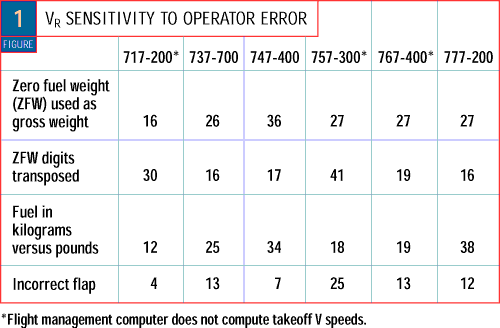
3. CONSEQUENCES OF ERRORS
If human error in determining takeoff reference speeds is not caught and corrected, the following adverse effects can result:
- Tail contact with the runway. Premature rotation reduces runway tail clearance. Erroneously low VR on takeoff has been recorded as the cause of several incidents of tail strike.
- High-speed RTO. The airplane will not lift off at the normal attitude or time. This abnormal performance has prompted flight crews to perform high-speed RTOs.
Other effects may be less obvious, and are usually not significant with all engines running. However, they may become very significant if combined with an engine failure:
- Overweight takeoff. This can occur if the flight crew subsequently uses erroneous GW to decide whether a runway is acceptable for departure.
- Increased runway length required. Premature rotation increases drag and significantly increases the distance from rotation to liftoff.
- Reduced obstruction clearance. Increased drag is present from the point of rotation until the airplane accelerates to the normal climb speed profile. Climb gradient is reduced during this time.
- Degraded handling qualities. After liftoff, there is reduced manoeuvre margin to stall until the airplane accelerates to the normal climb speed schedule. Achieving the proper climb speed schedule probably will not occur until after the airplane passes acceleration height, because takeoff safety speed (V2) will also be erroneously low.
4. RECOMMENDED PRACTICES
The systems and procedures that operators use to determine takeoff reference speeds vary considerably. However, Boeing has identified some guidelines to reduce the likelihood of error while calculating these speeds, regardless of the specific process followed:
- Provide accurate weight data to the person responsible for determining takeoff reference speeds.
- Present the weight data in a clear and unambiguous format.
- Establish procedures to manage time pressure and out-of-sequence operations.
- Always enter ZFW on FMC-equipped airplanes.
- Establish reliable procedures for verification of manual operations.
Provide accurate weight data to the person responsible for determining takeoff reference speeds.
Although this may appear to be an obvious step, it is important to perform in order to reduce the many opportunities for error that can occur when determining ZFW and fuel weight. Each operator should provide a robust process and proper training for any personnel who may be responsible for computing ZFW, GW, and fuel weight (when required). All weight computations should be performed in the dispatch office or an equivalent environment that is subject to fewer distractions than exist on the flight deck.
Training and procedures must include information to ensure that conversion to proper units, such as kilograms to pounds, is accomplished when needed and performed correctly. Operators should exercise special care if dispatching an airplane under the MEL with the fuel quantity indication system inoperative. They should also ensure that all airline MEL procedures are followed to determine actual fuel on board. Because human error can occur when transcribing numbers from one document to another, the process for computing the final values for the load sheet should minimise the number of times that numbers must be transcribed from the initial source to the final product.
Present the weight data in a clear and unambiguous format.
The load sheet should be formatted to reduce the possibility that the pilot will select the wrong weight value for making performance calculations. Boeing has revised its standardised load sheet to highlight the ZFW value, and has added the note “Enter ZFW into FMC” to further highlight the ZFW value (figure 2). Boeing recommends that operators who use their own load sheet review its format and modify it, if necessary, to decrease the number of opportunities for the pilot to select the wrong weight value. This recommendation also applies to the format of the aircraft communications addressing and reporting system (ACARS) display and printout for operators who use ACARS to uplink weight data to the flight deck.
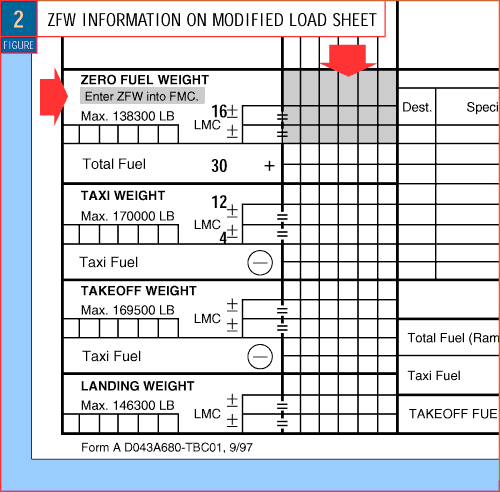
Establish procedures to manage time pressure and out-of-sequence operations.
Operators must first ensure that their normal operating procedures permit sufficient time for the flight crew to perform the steps of determining V speeds carefully and with proper verification. Secondly, if a task must be performed out of the normal sequence, time pressure and multitasking can occur, which increase the risk of error. Therefore, operators should establish processes to ensure that final weight data is ready for the flight crew in time to conduct normal preflight procedures in sequence. Finally, if it becomes necessary to enter or update the weight data after engine start or push-back, the flight crew must be sure to use the same care and verification procedures they would use if the airplane were still at the gate. Operators should encourage flight crews to take whatever measures are necessary to ensure that this can be achieved.
Always enter ZFW on FMC-equipped airplanes.
This is essential because ZFW, once established, is a constant value for the entire flight, but GW changes as fuel is burned. Also, planned fuel weight may not equal actual fuel weight because of variations in fuel density or a math error, such as a unit-conversion error. By entering ZFW, the flight crew uses a known, constant value and lets the FMC perform the calculation. The FMC will apply the current, actual fuel on board to obtain the most accurate and less error-prone value for GW. The FMC will also maintain an accurate GW for the remainder of the flight. Another reason to always enter ZFW is that flight crews who alternate between using GW and ZFW become accustomed to using both fields on the PERF INIT page. The Boeing position is that these flight crews are more likely to enter a weight value on the wrong line (GW on the ZFW line or ZFW on the GW line). In January 2000 Boeing began modifying all operations manuals, as necessary, to indicate that entering ZFW is the normal procedure. These revisions for all Boeing commercial airplanes will be completed by January 2001.
Establish reliable procedures for verification of manual operations.
Human error continues to occur while calculating takeoff reference speed, even with the training and procedures designed to minimise such error. However, a thorough check by another properly trained person should reduce, by several orders of magnitude, the likelihood that these errors will not be caught. Operator procedures and training must be established to ensure that this verification is accomplished consistently and carefully. The appropriate method of verification, however, is different for automated systems and manual systems:
-
For the FMC and other computerised systems, one flight crew member should always cross-check CDU entries made by the other flight crew member. The FMC and other equivalent computerised systems are certified to produce accurate results based on accurate input. When the input is wrong, the results are wrong, so operators must ensure that the input is correct. Procedures must be modified, if necessary, to state that the entries of one flight crew member must receive a thorough verification from the other flight crew member. The verifying flight crew member needs to confirm that the correct values have been entered, and that they have been entered onto the correct lines on the PERF INIT and TAKEOFF REF pages (figure 3). As an additional step to detect an input error, both flight crew members should also cross-check the resulting GW value against the planned GW on the load sheet.

-
For operators who use manual processes to compute takeoff parameters, takeoff reference speeds should be determined by two independent processes and compared. The independent processes could involve two personnel, either two flight crew members or a flight crew member and a dispatcher, independently using the same method, such as the airport/runway analysis chart. It could also involve the use of two different methods to determine the values, such as a lookup table and a performance chart.
-
Manual operations to set speed bugs also require verification. On airplanes equipped with an FMC that calculates V speeds, or into which dispatch-calculated V speeds can be entered from an uplink, the FMC and display system automatically set the speed bugs. Because this process is not subject to human error, no special speed bug verification is required as long as the original data entries were verified. Other airplanes require manual entry of takeoff reference speeds through the CDU, the speed reference selector, or physical positioning of the bugs. Because manual entry provides an opportunity for human error to enter the process, verification is required at this step as well. Operating procedures should include a requirement for both flight crew members to confirm that the bugs are set correctly. Regardless of how the speed bugs are set, V2 must also be set manually in the mode control panel IAS/MACH window as the target reference speed. This manual entry also requires verification.
5. SYSTEM AIDS
In addition to a reliable process for calculating takeoff reference speeds, some automated system features can help prevent the errors that may result from this process: ACARS with FMC communications feature and GW entry inhibited.
ACARS with FMC communications feature.
For airplanes with ACARS and a suitably equipped FMC (see paragraph below), ZFW and takeoff reference speeds may be unlinked directly from the operations office into the FMC. Flight crews can send a request for data to their operations centre directly from the PERF INIT page of the CDU. Data may also be uplinked to the airplane unsolicited as part of normal procedures. Received data is displayed on the CDU. After verification, the flight crew member simply needs to accept the data, and can do so by pushing the ACCEPT line select button.
This uplink capability requires the airplane's FMC to be equipped with the FMC communications feature and either the performance initiation function or the takeoff data function, or both. These features are available on current-production 737, 757, 767, and 777 airplanes. The ACARS/FMC system can eliminate several, but not all, potential sources of error. Weight data must be entered manually at some point in the calculation process, so verification is still required in the dispatch or operations office to ensure that the numbers entered manually were correct.
GW entry inhibited.
Another system approach for reducing calculation errors would be to disable the manual entry of GW on the PERF INIT page. This proposed feature would eliminate the possibility of a flight crew member inadvertently line-selecting the ZFW onto the GW line. (This option will not affect the current capability to manually enter GW on the Approach Reference page.) Boeing will make this feature available as an option in future FMC software updates. Figure 4 lists the targeted FMCs and probable incorporation points.

6. RISK ASSESSMENT CHECKLIST
Boeing has developed a risk assessment checklist to help operators assess the adequacy of their own processes for determining correct takeoff reference speeds (see below). This checklist consists of a series of questions and relevant examples for self-evaluation. Operators are encouraged to review their operating procedures using this checklist and to adjust their processes to address any deficiencies that may be revealed as a result.
SummaryThe occurrence of human error while establishing takeoff reference speed has caused tail strike, high-speed RTOs, and other instances of degraded performance. These errors can occur in a variety of ways. Operator procedures are the primary means for eliminating these errors. Establishing proper procedures can reduce these errors by helping flight crews avoid situations that make the initial error more probable. These procedures must also ensure that any error that does occur is caught and corrected before it can cause a problem during takeoff or initial climb. The primary method for eliminating error is to ensure that comprehensive, independent verification steps are accomplished at key points where a manual task is performed. Operators are encouraged to review each step of their process and make adjustments to address any deficiencies they may uncover. Boeing has developed a risk assessment checklist as a tool for this review. Operators should also consider two automation features that eliminate known points of error input. One is the ACARS/FMC communications feature, which is available on most current-production airplanes. The other feature is the option to disable FMC GW entry, which will become available with future FMC software updates. |
TAKEOFF REFERENCE SPEEDS RISK ASSESSMENT CHECKLIST
By using the following checklist, operators can assess the adequacy of their processes for determining correct takeoff reference (V) speeds. Each process is followed by a question, a rating of the degree to which an error committed in the process can affect takeoff, and examples of practices (best, good, and poor) used to complete the process:
- Determine zero fuel weight.
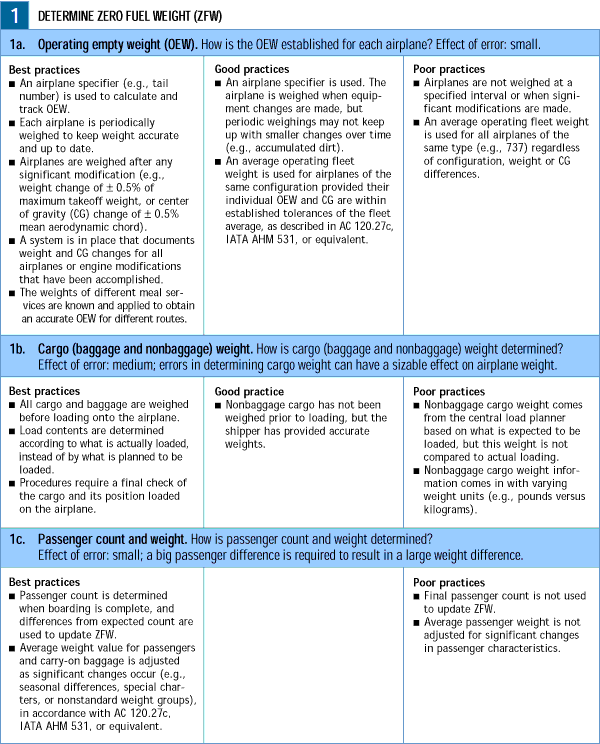
- Determine gross weight.
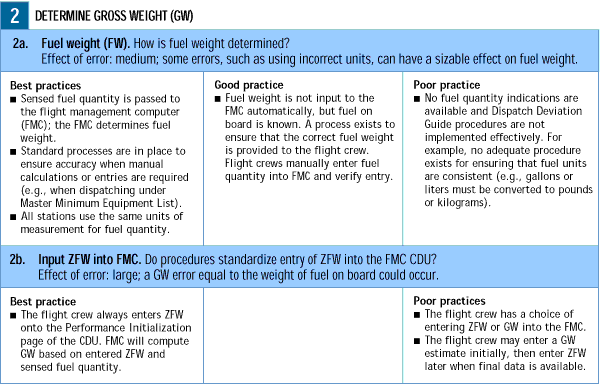
- Communicate weights to flight crew.

- Include complete information for deriving V speeds.

- Cross-check manual operations.

- Set speed bugs.

BOEING ACTIVITIES RELATED TO ERRONEOUS REFERENCE SPEED
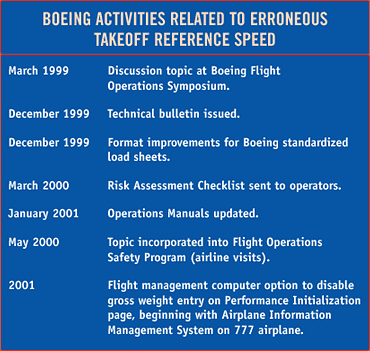
FRANK SANTONI
777 CHIEF PROJECT PILOT
ENGINEERING FLIGHT TEST
BOEING COMMERCIAL AIRPLANES GROUP
JIM TERHUNE
LEAD ENGINEER
ENGINEERING FLIGHT TEST
BOEING COMMERCIAL AIRPLANES GROUP
| Top of page | Boeing Home | Boeing Commercial | Contact Aero |
Aero Copyright © 2003 The Boeing Company. All rights reserved.